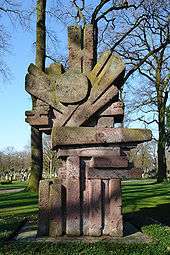Bremen Soviet Republic
| Bremen Soviet Republic | ||||||||||||||
| Bremer Räterepublik (German) | ||||||||||||||
| Unrecognized state | ||||||||||||||
| ||||||||||||||
 Flag | ||||||||||||||
.svg.png) | ||||||||||||||
| Capital | Bremen | |||||||||||||
| Languages | German | |||||||||||||
| Government | Soviet republic | |||||||||||||
| People's Commissar/President | Johann Knief | |||||||||||||
| Legislature | Soviet of People’s Representatives | |||||||||||||
| Historical era | World War I | |||||||||||||
| • | Established | 10 January 1919 | ||||||||||||
| • | Disestablished | 4 February 1919 | ||||||||||||
| Currency | "Papiermark" (ℳ) | |||||||||||||
| ||||||||||||||
| Today part of | | |||||||||||||
The Bremen Soviet Republic was an unrecognised, short-lived state, existing for 25 days in 1919. It consisted of the state of Bremen, Germany.[1] The republic was established amid the German Revolution (after defeat of the German Empire in World War I).
History


Preceding events
After the abdication of the Kaiser on the 9 November 1918, Germany fell into a state of instability. The Social Democratic Party of Germany (SPD)-led government and the Spartacus League both announced the launch of a German Republic (with the latter aiming for a "Free Socialist Republic").[2] This led to civil war and the German Revolution of 1918-19 with the two opposing sides fighting for power.
Before the creation of the Soviet state, radical labour movements already enjoyed significant support in Bremen (due to high employment levels in heavy industry) with the SPD electorally dominating the city (a trait seen to this day).[3] As a result, with the outbreak of the civil war, Bremen was strongly sympathetic to the left-leaning Spartacus League. The revolt in Bremen began just before the abdication of the Kaiser (6 November 1918) with a workers' council being established and elected. This council sat in Bremen City Hall and managed the affairs of the small state independent of the newly established, SPD-led, Weimar Republic in Berlin.[4]
Establishment

On 10 January, the worker's council declared the republic setting up the Soviet of People’s Representatives within the city. Academics, most notably Johann Knief, made up the bulk of the leadership professing support for many Leninist theories.[3] The Soviet of People’s Representatives replaced the worker's council and was also housed within the city hall. After its formation, the council passed much reformist legislation including the requirement to equal pay. The long term aim, though never realised, was also to nationalise the economy of Bremen establishing a dictatorship of the proletariat.
Defeat
By early 1919, the Weimar Republic held a strong enough position in the civil war to challenge the state. As a result, Friedrich Ebert sent the Freikorps into Bremen to successfully topple the republic.[5] Unlike the Bavarian Soviet Republic the suppression of the worker's council in Bremen cost the lives of over 80 individuals (including the leaders whom were executed).[4] The Bremen Soviets fell quickly due to the geographical nature of the state (it was surrounded by Weimar Germany controlled territory so could not source support from the Spartacus League). The city of Bremen fell on 4 February with Bremerhaven holding out until it was defeated on 8/9 February.
Government
The Soviet of People’s Representatives held the role of legislature and totaled nine representatives (consisting of three Communist Party members, three USPD members and three independent soldiers)[1] Johann Knief, a member of the independent SPD group, held significant influence within the republic holding the role of People's Commissar.[3] It was formed from the worker's council established in November 1918 with a similar membership makeup.
See also
- Aftermath of World War I
- Eugen Leviné
- History of Bavaria
- Rat (council)
- Bavarian Soviet Republic
- Alsace Soviet Republic
External links
- Group Workers' Policy: The Bremen Left Radicals. From the history of the Bremen workers' movement until 1920. (PDF; 5,1 MB) (In German)
- The Bremerhaven Republic from a syndicalist perspective. (PDF; 894 kB) (In German)
References
- 1 2 "The Great Soviet Encyclopedia, 3rd Edition".
- ↑ Priestand, David (2009). The Red Flag: A History of Communism. New York: Grove Press. ISBN 0802145124.
- 1 2 3 Bourrinet, Philippe (2016). The Dutch and German Communist Left (1900 68): Neither Lenin Nor Trotsky Nor Stalin! - All Workers Must Think for Themselves!. Historical Materialism Book. 125. Brill. p. 78. ISBN 9004269770.
- 1 2 Schnell, Andreas (2004). "Alle Mächt den Räten!" (in German).
- ↑ Grange, William (2008). Cultural Chronicle of the Weimar Republic. Scarecrow Press. p. 27. ISBN 081085967X.
